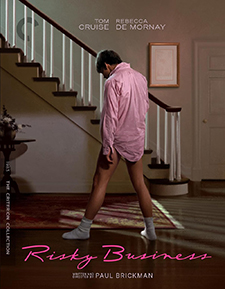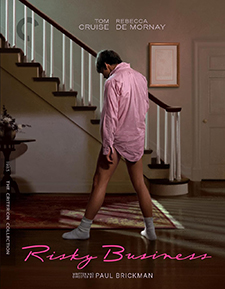Risky Business (Blu-ray Review)

Director
Paul BrickmanRelease Date(s)
1983 (July 23, 2024)Studio(s)
The Geffen Film Company/Warner Bros. (The Criterion Collection – Spine #1227)- Film/Program Grade: B+
- Video Grade: A
- Audio Grade: A
- Extras Grade: A+
Review
Risky Business is the smart and sexy teen comedy that made a bona fide star of Tom Cruise. In the 1980s, the decade when Hollywood released a teen comedy nearly every week, Risky Business rose above the others to capture Reagan-era capitalism in a tale of young man’s encounter with an entrepreneurial prostitute.
Cruise (Jerry Maguire) stars as Joel Goodson, a strait-laced, above-average high school student in an affluent suburb of Chicago, whose parents take a brief vacation and leave him home alone. It’s a busy time in Joel’s life. He’s facing college board exams, an interview with a Princeton admissions officer, and finals at school.
Learning that Joel’s parents are away for a few days, his friends try to talk him into moving out of his comfort zone, taking chances, and focusing on more than college. Sometimes, they tell him, you just have to shrug your shoulders and say “What the f—!” Meanwhile, Joel’s been having erotic dreams of a naked woman beckoning to him from a steamy shower, and his hormones are on full thrust.
Instigated by his friends, Joel gets himself into an escalating series of troubles when he calls a number in a sex magazine and young hooker Lana (Rebecca De Mornay, The Hand That Rocks the Cradle) moves into his house. He gets involved with Lana’s pimp (Joe Pantoliano, Bound), his mother’s expensive Steuben egg is stolen, his father’s Porsche winds up in Lake Michigan, and he misses two crucial finals.
As a member of the Future Enterprisers club at school, Joel looks forward to pointers for reaching his goal of majoring in business. The opportunity to make money comes sooner than he expects. Lana suggests there would be big bucks in matching up Joel’s friends with hers. Horny, affluent boys are quite willing to spend for the services of a professional. Soon, the family home becomes a brothel with no end of enthusiastic customers lining up. At one party, the Princeton admissions rep (Richard Masur, Rent-a-Cop) shows up and interviews Joel while Lana argues, holding a mattress, that she needs the room. The venture soon garners several thousands of dollars, but there are consequences ahead.
Risky Business owes a lot to The Graduate in its tale of a young man getting involved with a far more worldly woman. Cruise conveys innocence and vulnerability but also generates sexual energy, making him a perfect fit as Joel. He’s particularly adept at conveying Joel’s feelings with looks and reactions. He doesn’t need a slew of words to make the point. And he’s helped by writer-director Paul Brickman’s dialogue, which is spare and very funny. The film leans into satire without sacrificing laughs.
Lana is essentially the “hooker with a heart of gold,” but De Mornay makes her more than a cliche. Smart, recognizing an opportunity and unafraid to act on it, Lana would be a great contestant on Shark Tank with her persuasive manner, beauty, charm, and an original idea for making money if her business were legitimate. Her sensual scenes with Cruise definitely generate heat, and the role never takes her into tired, familiar territory.
The chemistry between Cruise and De Mornay is a major reason the film works so well. The two actors click when they’re together on screen. Though a temporary brothel that lets adolescent boys realize their fantasies is far-fetched, Brickman works the situation without burlesquing it or making it an Animal House type of picture. Risky Business is surprisingly reserved and well structured, establishing a kind of comic suspense as we wonder how Joel will extricate himself from his predicament before his parents get home.
Risky Business was shot by cinematographers Bruce Surtees and Reynaldo Villalobos on 35 mm film with Panavision Panaflex cameras and lenses, and presented in the aspect ratio of 1.85:1. According to information in the enclosed booklet from The Criterion Collection, the restoration was supervised and approved by director Paul Brickman and producer Jon Avnet. “The new 4K restorations of the director’s cut and theatrical release were created from the 35 mm original camera negative and a 35 mm interpositive.” The film looks great, with excellent contrast and clarity. The Blu-ray is pristine and looks bright and vibrant. The color palette is generally on the bright side, with Lana’s outfits especially becoming. Faces are rendered flatteringly, with De Mornay’s peaches-and-cream complexion quite lovely. Cruise’s iconic underwear dance to Bob Seger’s Old Time Rock & Roll is shot from numerous angles to maximize Joel’s feeling of uninhibited freedom.
The soundtrack is English 5.1 DTS-HD Master Audio. Optional English SDH subtitles are available. According to information in the enclosed booklet, the 5.1 surround soundtrack was remastered from the original magnetic tracks. Dialogue is clear and distinct. Ambient sound is mixed well with dialogue and music. A key sound effect is the roar of the Porsche’s engine as Joel races it through the streets. Tangerine Dream’s score is just right for the mood of the film. It conveys suspense as well as sensuality and never overwhelms the story. Songs include In the Air Tonight by Phil Collins, The Pump (Jeff Beck), Swamp (Talking Heads), Mannish Boy (Muddy Waters) and After the Fall (Journey).
Both the director’s cut and theatrical release versions of Risky Business are included on the Blu-ray release from The Criterion Collection. There’s also a 2-Disc 4K Ultra HD edition available, while the bonus materials, listed below, are the same for both editions:
- Audio Commentary with Paul Brickman, Jon Avnet, and Tom Cruise
- Interview with Producer Jon Avnet (20:34)
- Interview with Casting Director Nancy Klopper (18:09)
- Conversation with Editor Richard Chew (30:13)
- The Dream Is Always the Same: The Story of Risky Business (29:29)
- Screen Tests (14:36)
- Trailer (1:29)
Audio Commentary – This commentary was recorded for the theatrical release in 2008. Producer Jon Avnet, director Paul Brickman, and actor Tom Cruise reminisce about their involvement in Risky Business. The film was made during the Reagan era, when many young people were interested, first and foremost, in making money. David Geffen was willing to make the film when no one else in Hollywood was interested. Cruise hadn’t slept for 36 hours, having just filmed scenes for The Outsiders in Oklahoma, when he landed in Los Angeles and went directly to the apartment of producer Steve Tisch for his audition. During his audition, Cruise kept interrupting himself, claiming he could do better and then giving different readings. He was also open to Brickman’s suggestions. The three men speak about the soulful score by Tangerine Dream and discuss several scenes in detail. The shower scene took 18 hours to film. During a poker scene, everyone got sick from smoking cigars. Brickman talks about his method for writing a script, which includes rewriting when a scene doesn’t work. Brickman’s original title was White Boys Off the Lake, but because it sounded more like the title of an off-Broadway play, it was dropped. Every character in the film has integrity. Brickman was eager to get away from Hollywood for filming, and much of the film was shot in and around Chicago. Cruise and Brickman discuss how the iconic scene of Cruise lip synching to Old Time Rock & Roll was developed. Cruise says it was important to understand the purpose of the scene and know how far to go in adding his own touches. The filmmakers discuss the rhythms of various scenes. Brickman wonders whether Cruise brought some of Joel Goodson to his portrayal of Jerry Maguire. The original poster art featured a cartoon version of Joel surrounded by buxom beauties with money drifting down, but that didn’t convey the proper tone, and Cruise peering over a pair of sunglasses became the film’s advertising image. The commentary concludes with Cruise thanking both Avnet and Brickman for trusting him to play Joel.
Interview with Producer Jon Avnet – In this interview from 2004, producer Avnet discusses his collaboration with director Paul Brickman, including the genesis of the film, its pre-production obstacles, and its marketing strategy. Avnet talks about the period when the film was released and the changes in Hollywood at the time, notably the rise of teen comedies.
Interview with Casting Director Nancy Klopper – In this 2024 interview, Klopper talks about the search for the cast of Risky Business. A number of minor characters were cast before the roles of Joel and Lana were filled. Klopper refers to her job as instinctive. She apprenticed under casting director Lynn Stalmaster and cast many TV movies for the production company Avnet/Tisch. She felt in sync with Paul Brickman when they met, and understood what he was looking for in Joel. Many up-and-coming actors were auditioned, and there was a months-long search for Joel. Polaroid photos of actors who auditioned for the lead are shown. The film couldn’t be greenlighted until there was a lead. Cruise was shooting The Outsiders but flew to Los Angeles for an audition and it was immediately clear that he was Joel. He was good-looking, likable, and conveyed a nobility. De Mornay possessed many of the qualities of Lana. She didn’t have a lot of experience, so Klopper worked with her on the role. Cruise and De Mornay were filmed in the early morning as they ran through a scene from the script and it was clear that they had definite chemistry.
Conversation with Editor Richard Chew – This interview from 2024 is conducted by film historian Bobbie O’Steen. Chew and O’Steen speak about decisions made for specific sequences in Risky Business. The film had an edge, and there are references to The Graduate. A sex scene on a train was sketchy in the script, so Chew used train footage interspersed with the lovemaking between Joel and Lana. Director Paul Brickman built the scene by adding other passengers, contributing to sexual tension as one passenger after another leaves the car. Chew speaks about the technique of “step printing,” which is either slowing up or slowing down film speeds. A lot of editing choices are the result of “happy accidents.” The score is composed of minimalist, avant-garde music. Tangerine Dream’s music had electronic layers and a sensual vibe.
The Story Is Always the Same: The Story of Risky Business – In this featurette from 2008, Jon Avnet, Paul Brickman, Tom Cruise, and Rebecca De Mornay and other major collaborators share stories about the making of Risky Business. “It was very much a hot picture,” notes one crew member. Cruise claims that he was just trying not to get fired. Broad sex comedies were easier to make in the 1980s. Risky Business proved that a teen comedy could be smart and sophisticated.
Booklet – The accordion-style, fold-out booklet contains, one one side, the essay Coming of Age in Reagan’s America by Dave Kehr, cast and crew list, and information about the film’s digital restoration. On the reverse is the Risky Business poster of Cruise looking over his Ray-Ban Wayfarer sunglasses.
Risky Business is slow getting into the main plot. The film hasn’t aged well, and the improbability of the plot stands out more now than maybe back in 1983, when it seemed daring and clever. The performances still hold up, with the exception of Joel’s clueless parents, who seem plucked from an episode of Leave It to Beaver. The undeniable rapport between Tom Cruise and Rebecca De Mornay is the key to the film’s enduring popularity. Today, it’s remembered as the vehicle that proved Tom Cruise could carry a picture and established him as a bankable star.
- Dennis Seuling

